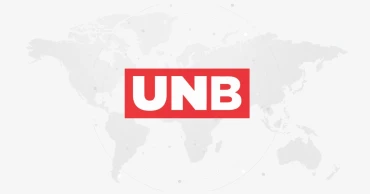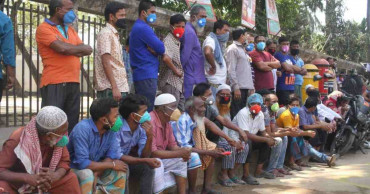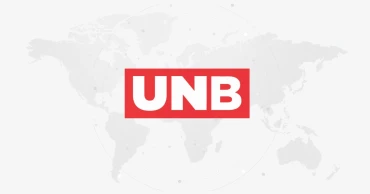New Poor
Pandemic's fallout: A shrinking middle-class and the 'new poor'
The pandemic has had a damaging impact on both urban and rural Bangladesh -- while many lost their jobs in cities and returned to their native villages, households after households plunged into poverty in the countryside.
Since the imposition of the first lockdown in 2020, closures of small businesses like grocery shops in the rural and semi-rural areas have meant less income available for families. Covid-induced supply chain disruptions reduced farm outputs, hitting hard the farmers and those running agri enterprises.
Read: Govt to widen social safety coverage to protect poor from pandemic loss
In fact, for many households in Bangladesh, Covid wiped out their entire life savings -- many tucked into their financial cushion to ensure two square meals a day for their families and cover the basic healthcare expenses. The financial aid by the government indeed helped, but helped a little only.
As health experts warn of an imminent third wave of Covid, economists say that a large chunk of small traders across rural Bangladesh and the erstwhile middle-class (who migrated back from cities) have been hit hard by the pandemic-induced liquidity crunch.
According to Prof Mustafizur Rahman of the Centre for Policy Dialogue, a large portion of the population above the poverty line in rural Bangladesh -- the middle-class -- has fallen below the economic marker. "They are now among the marginalised population or the 'new poor'," he said.
3 years ago
Finance Minister dismisses the claim of 2.5 crore new poor
Finance Minister AHM Mustafa Kamal on Wednesday discounted a claim that the coronavirus pandemic has made up to 2.5 crore new poor in the country.
“I don’t believe that 2-2.5 crore people are now below the poverty line. I need to know from where some research organizations have collected the figure”, he told a reporter after attending a meeting of the Cabinet Committee on Public Purchase.
Read: ARTICLE 19 lauds tax exemption move for 3rd gender citizens in proposed budget
He said the government has its own research bodies and they are now working on it. “I will look into it when the government bodies complete their findings”.
He said no figure will be acceptable before the government’s own research bodies’ present their findings.
Read: JS passes Tk 13,987.27 cr supplementary budget
Defending the proposed national budget for fiscal 2021-22, the finance minister said his budget has no weak points.
Trashing the comments of some economists that the budget has failed to address the problems of corona-affected low income groups, he said everything in the budget is strong.
Read: New budget proposals inadequate in tackling poverty, say rights groups
“You will see the results of the budget that it would serve the interest of poor people when implementation starts”, he said.
He said he has followed the Prime Minister’s instruction to bring the poor people within the mainstream of the economy.
4 years ago
Economists urge government to present pro-poor budget
Amid the rising number of new poor in Bangladesh due to the COVID-19 pandemic, economists suggest the government should go for a pro-poor national budget that safeguards both their lives and livelihoods.
In line with that suggestion, they are urging the government to prioritize the social safety net, employment, small and medium enterprises (SMEs) as well as the health, education and agriculture sectors in the upcoming budget.
They said the poor [particularly day labourers, hawkers, beggars, rootless people, security guards, maids, transport and restaurant workers and people affected by natural disasters] across Bangladesh have been facing emerging vulnerabilities escalating debt and declining savings one year into the pandemic.
Read Policy implementation needed for poverty eradication: Speakers
According to the report of Power and Participation Research Centre (PPRC) and BRAC Institute of Governance and Development (BIGD), the Covid-19 pandemic has caused 24.5 million new people to fall below the line of poverty between June 2020 and March 2021, and the debt burden has doubled for people living in both urban and rural areas. The majority of the new poor are to be found in the urban areas.
“There was a 4% rise in extreme poverty within the study sample. Despite some recovery, national estimate of ‘new poor’ in March 2021 stood at 14.7% which translates into a population of 24.5 million,” the survey titled One Year into the COVID-19 Crisis by PPRC and BIGD showed.
The data also showed that households are faced with a 2nd wave crisis with significantly depleted coping capacity - savings depleted by 24% and 11% in rural and urban respectively. Meanwhile the debt burden doubled during the period for most groups. It is worth remembering that income drop for the poor and vulnerable was above 70% immediately after the 1st wave in March- April, 2020 according to the report.
Also read: The shadow of coronavirus on Bangladesh’s poor
“One year from the crisis, 50% of the ‘new poor’ remain stuck in poverty. However, 8% of pre-COVID employed were still unemployed in March 2021. Around half were in their pre-covid occupation but 41% had to move to another occupation. The unemployment rate remains high for skilled labour, salaried jobs and housemaids,” it also said.
The data mentioned that 47% of the early migrants were non-poor before the pandemic and 57% of early migrants moved to other cities. On the other hand, one-third (61%) of late migrants were poor before the pandemic and majority (60%) of late migrants moved to villages.
There was a 98% rise in non-food expenditure burden between June 2020 and March 2021. Besides, significant rises in all items such as Rent – 46%, Health –81%, Transportation – 104% and Utility – 51%, were recorded in the recent survey.
Also read: Beggars passing days in increased hardship during lockdown
It also showed that three drivers of vulnerability during covid crisis- Uncertainty of preferred employment, Non-food expenditure burdens – 98% rise in urban areas and near-absence of social protection support – help from government – 9% to 2%, NGOs - 3% to 1%, employer – 1% to 0%, and local community – 5% to 2% - all declined in the period.
Executive Chairman of PPRC Dr Hossain Zillur Rahman said although social protection is playing only a token role in Covid response it is a critical priority.
“Parallel to existing safety nets, there is urgent need for specific new and significant programs for urban poor and ‘new poor’ with effective targeting and leveraging technology,” he further added smart lockdown to avoid such a new income shock is both a health and an economic priority.”
Read COVID-19 shatters Bangladesh's dream of eradicating poverty
As a final policy message, the economist emphasized that to tackle women and ‘new poor’ caught in an emerging poverty trap due to vulnerability of the ‘meso-economy’ including CSME sector, a targeted and ‘big-push’ is necessary for which the study calls for an urgent national CSME recovery action plan.
Talking to UNB, the research director of Centre for Policy Dialogue (CPD) Dr Khandaker Golam Moazzem appreciated the government taking different programmes to assist the poor during the pandemic. Though, he criticized the distribution level.
"Someone takes assistance from the stimulus packages several times on the other hand someone is deprived of it. So, transparency should be ensured in the distribution level so that new poor get funds from the packages properly,” he added.
Read Nations must work together to reverse setbacks to poverty ...
The economist said there are a good number of Non Governmental organizations (NGOs) in the country who work with slum dwellers and rootless people. The government can take support from them to make an accurate list to provide funds in the right way. We need accountability to address it. So the government should work with them.
“The impact of the coronavirus won’t depart from the country in the next two years. Poor people should be provided enough assistance two times in a single year. So social safety net programmes should be prioritised more in the upcoming budget,” Moazzem said.
Moazzem added that the national budget for FY2021-22 is being prepared in the backdrop of a number of disquieting developments in the economy- weak performance of FY2020-21 budget implementation, the persistence of adverse impacts of the first wave of COVID-19, continuing stagnation in private investment, the second wave of the COVID-19 pandemic, and failure of the external sector to pick-up. So, the upcoming budget will need to address these as also the medium-term fiscal reform issues with a view to making a recovery sustainable.
Read Poor people to get highest priority in next budget: Finance Minister.
4 years ago
Post-pandemic recovery depends on reliable data
The recovery of the country’s economy following the coronavirus crisis is long and slow due to data scarcity, experts say.
5 years ago






